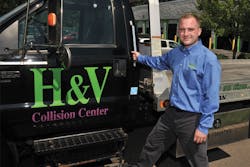Founded in 1973 by Vartan Jerian Sr., H&V Collision Center has grown from a 1,500-square-foot building with two employees in Troy, N.Y., to a seven-shop operation stretching across the state’s eastern border.
And with that growth comes a unique opportunity for improving cycle time and workflow throughout the entire company: load leveling.
The ability to distribute work between various locations allows you to ease the workload of shops operating at overcapacity and improve the productivity and revenue of an underperforming location.
Once H&V opened its third location, Vartan Jerian Jr., who now runs the business, says he knew his operation would have to consider load leveling to improve production—and mastering that art has taken years.
We initially came up with some basic guidelines and continue to improve on our load leveling process. Our operations manager and I initially devised the basic plan and we have grown off that with the assistance of our location manager. In the beginning stages, we tried everything: cars that had been disassembled and cars that were whole; cars with parts, cars without parts. It's much easier when the shop that's receiving the car gets the entire car and does its own parts ordering. Now we don't move any cars that are disassembled, unless it's a straight-to-paint car.
Deciding what cars will go to which shop is based on the accepting shop’s capacity. To determine that, communication is very important. We look at our reports daily to see everybody's work in progress. Managers at each shop communicate via email, usually at the beginning and end of the day. "Hey, I've got nine more coming in. Does anybody need cars?" If nobody says they need cars, then we try to spread more between the shops so that one shop doesn't get completely overloaded.
Each shop has a person that will generally coordinate with our call center. The call center dispatches one of our three tow trucks and coordinates the drop-off and pick-up. Everyone from the sending and receiving location is notified and the files are noted so everyone knows what is going on. All customers are notified upon drop-off that their vehicles may be moved to another facility. We ask every customer before they drop their car off if they're okay with us moving it to another location. If not, we'll tag it and it stays at that facility.
We decide where cars are going immediately. In our initial stages, the car staffer waited two to three days to determine if a car needed to be load leveled, which was horrendous. The customer was mad because the car was just sitting in another shop for a day not being worked on. It still happens occasionally, but in 90 percent of the cases, we know the car is getting load leveled beforehand because we know how close each shop is to capacity.
You absolutely need to purchase your own tow trucks. The cost to transfer vehicles by another vendor would not be very cost effective otherwise. We have two flatbeds and one medium duty truck that perform our daily load leveling. We average 350 cars per month between all seven locations, and three trucks have been able to handle that.
Transferring the vehicle does change the DRP process. For most of our direct repairs, we have the ability to transfer vehicles to a facility that has capacity. However, we usually need to cancel assignments and have them reassigned. We currently use CCC ONE Contact Center for our call center, which allows us to do this pretty seamlessly.

